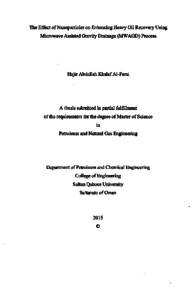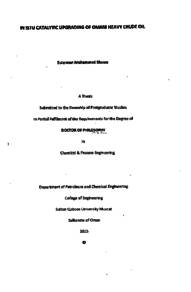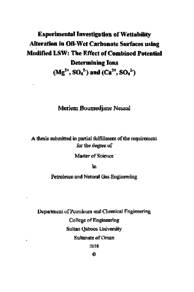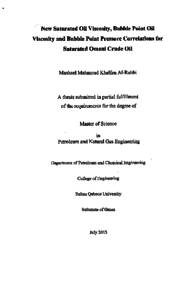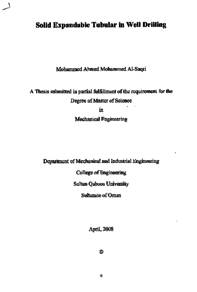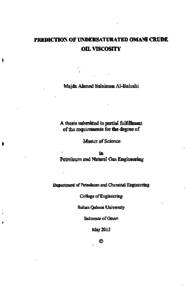Document
The effect of nanoparticles on enhancing heavy oil recovery using microwave assisted gravity drainage (MWAGD) process
Publisher
Sultan Qaboos University
Gregorian
2015
Language
English
English abstract
There are many heavy oil reservoirs around the world, which are, representing about 70% of the total oil resources in the whole world. The primary heavy oil recovery is low, so enhanced oil recovery (EOR) methods are needed. In most of the cases for recovering heavy oil, reducing the oil viscosity is the main mechanism, so thermal EOR methods are used. Conventional thermal EOR methods face many challenges in recovering heavy oil like high heat loss, low efficiency in thin reservoirs, and environmental problems. To overcome these challenges, unconventional thermal EOR methods such as electromagnetic heating methods are used. These methods have some limitations like low depth of penetration and high-energy consumption. Nanotechnology can be used to overcome the challenges of heavy oil production process by the unconventional thermal EOR methods. In this study, nanoparticles were used to enhance the heavy oil recovery under Microwave Assisted Gravity Drainage (MWAGD) Process. Two types of metal oxides nanoparticles were used in this study that are Gamma Alumina (Y-Al2O3) and Titanium (IV) Oxide (TiO2) at 4 different concentrations. Besides studying the nanoparticles effect on the recovery, the effect of water saturation on the oil recovery, the influence of nanoparticles (type and concentration) on the emulsion viscosity and the distilled water thermal conductivity were also investigated. The tests were done by using heavy oil sample of 19.35 API and glass beads as a porous media with an average porosity of 22.2%. The results showed that, as the water saturation increases, the oil recovery from MWAGD process rises with an optimum recovery at a water saturation of 30%. Also, each type of nanoparticles (Y-Al2O3 and TiO2) has its own trend in affecting either the emulsion viscosity or water thermal conductivity. TiO2 nanoparticle has the greatest effect on the oil recovery at a low concentration of 0.05 wt% during MWAGD process. Our tests showed that, this method can be used to improve the performance of unconventional thermal methods for EOR.
Member of
Resource URL
Arabic abstract
هناك العديد من مكامن النفط الثقيل حول العالم و هي تمثل حوالي %70 من إجمالي موارد النفط في العالم بأسره. إن الإستخراج الأولى للنفط الثقيل منخفض؛ لهذا فإن هناك حاجة لاستخدام الطرق لاستخراج النفط. في كثير من حالات استخراج النفط الثقيل، تقليل اللزوجة هو الآلية الأهم ؛ لذلك تستخدم الطرق الحرارية المعززة لاستخراج النفط. تواجه الطرق الحرارية التقليدية لاستخراج النفط العديد من التحديات في استخراج النفط الثقيل مثل الفقدان العالي للحرارة، و انخفاض الكفاءة في المكامن الرقيقة، و المشاكل البيئية. و للتغلب على هذه التحديات، تستخدم الطرق الحرارية الغير تقليدية لاستخراج النفط وطرق التسخين الكهرومغناطيسية. هذه الطرق لديها بعض القيود مثل انخفاض عمق الاختراق ،و الاستهلاك العالي للطاقة. لذلك تقنية النانو يمكن استخدامها للتغلب على التحديات التي تواجه عملية انتاج النفط الثقيل باستخدام الطرق الحرارية الغير تقليدية لاستخراج النفط في هذه الدراسة، تم استخدام جزيئات النانو لدراسة تأثيرها في تعزيز استخراج النفط الثقيل بواسطة عملية الصرف بالجاذبية بمساعدة المايكرويف. نوعين من جزيئات النانو من نوع الأكاسيد المعدنية تم استخدامها في هذه الدراسة وهي جاما أكسيد الألمنيوم ( Y - Al2O) و أكسيد التيتانيوم (TiO2) و باربع تراكيز مختلفة. بجانب دراسة تأثير جزيئات النانو على استخراج النفط، تمت دراسة كل من: أثر التشبع بالماء على عملية استخراج النفط، و تأثير جزيئات النانو (النوع و التركيز على الزوجة المستحلب و التوصيل الحراري للماء المقطر. تم إجراء التجارب باستخدام عينة نفط ذي كثافة مقدارها 19 . 35 على مقياس API و خرز زجاجي کوسط مسامي مع متوسط مسامية يبلغ %22. 2 . أظهرت النتائج أنه كلما زادت نسية التشبع بالماء، زادت كمية النفط المستخرجة بواسطة عملية الصرف بالجانبية بمساعدة المايكرويف مع وجود نقطة مثلى عند درجة تشبع بالماء تبلغ %30. بالإضافة إلى ذلك، فإن كل نوع من جزيئات النانو قد أظهر اتجاها خاصا به في التأثير على الزوجة المستحلب و التوصيل الحراري للماء. جزيئات TiO2 كان لها التأثير الأكبر على استخراج النفط و بتركيز منخفض يبلغ %. 0 . 05wt خلال عملية الصرف بالجاذبية بمساعدة المايكرويف. تجاربنا أظهرت أن هذه الطريقة من الممكن استخدامها لتحسين أداء الطرق الحرارية الغير تقليدية لاستخراج النفط.
Category
Theses and Dissertations

